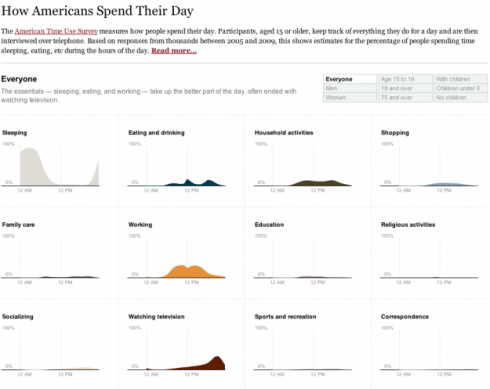Excellent demonstration of physics using popsicle sticks. Lots more here, including on how to make popsicle stick bombs and snakes (basically the tension of the structure gets released to create the movement).
Year: 2011
Forming, Storming, Norming and Performing
One of the first things we learned at Heifer was the process of group formation. It was also one of the last things they talked about so it must have been pretty important.
The four steps are:
- Forming: When the group first gets together, people tend to be cautious with one another. But because they’re so careful with what they say and what they do, newly forming groups don’t usually get much done.
- Storming: Now the barriers start to break down as individual personalities manifest themselves. People start speaking up. A lot. They become less polite. Conflicts arise. People become accusatory. There’s lots of energy, but because of all the conflict, they still aren’t able to get much done.
- Norming: The conflict begins to settle down as the group starts to work out its kinks, as all the individuals begin to adapt to one another. Groups may need guidance to get there because everyone has to stop fighting, but as it usually helps that the group will start to see successes because of successful co-operation.
- Performing: A well-functioning group can get a lot done. They’re able to communicate effectively, and take action effectively. Their productivity kicks into high gear and they can accomplish much together.
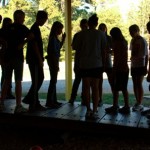
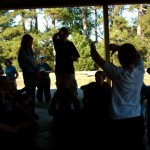
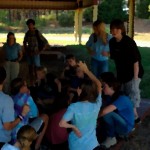
Not all groups get through all four steps, and every time the group changes, such as when a new member (like a new student) is introduced the groups will need to go through some version of the four steps as they learn to accommodate the newcomer.
A well established culture will help groups adapt to change. This is yet another benefit of multi-aged classrooms, because a healthy classroom culture eases the transition as older students leave and new students come in.
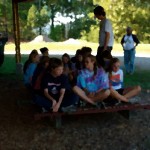
Even so, awareness of the four steps is extremely useful because it helps everyone anticipate that there will likely be some conflict, but that conflict is part of the group forming process and will likely diminish with time.
So you should expect, every year, to have to spend some time group building. Two weeks dedicated to orientation and teamwork is what Betsy Coe’s Montessori Middle School program uses. It’s a fair chunk of time to take out of the year, but because good groups can get so much more done, it’s well worth it to build a good classroom community.
Chlorine
“I’d like you to do chlorine too.”
“But I shouldn’t have to do chlorine. Chlorine was extra homework last time. I got Argon. I’ll do Argon. I don’t have to do extra homework today, so I shouldn’t have to do chlorine too.”
“It’s true, you didn’t earn extra work today.”
“So I don’t have to do chlorine.”
“If you do chlorine we’ll have the full set of elements.”
“But do I have to do it?”
“I’d like you to do it.”
“But do I have to?”
“No.”
“OK I’ll do it.”
Butterflies in the Herb Garden

At the Heifer International ranch. Time spent weeding the herb garden. Not much weeding done (by me at least), but much photography. Pretty. A word designed for butterflies.



Butterflies are classified as:
Kingdom: Animalia
Phylum: Arthropoda
Class: Insecta
Order: Lepidoptera
References
Maggie Eisenberger, personal communication.
Opler, Paul A., Kelly Lotts, and Thomas Naberhaus, coordinators. 2011. Butterflies and Moths of North America. Bozeman, MT: Big Sky Institute. http://www.butterfliesandmoths.org/ (Version 10/08/2011).
Flynn, J., 2007. Georgia Butterflies, Bibb Co. GA. http://www.shrike.net/butterflies/0-regions/bibb.htm (Accessed 10/08/2011).
How to Make Good/Useful Graphics
Flowing Data has a nice post that gets at how to make good images of data. It’s called, “5 misconceptions about visualization“.
The misconceptions:
- Visualization is for making data flashy
- Software does everything
- The more information on a single graphic, the better
- Visualization is too biased to be useful
- [A Visualization] has to be exact
Resorting to Poetry
We’re off to the Heifer International farm near Little Rock for a week. I have not been there before, but I suspect I’ll be disconnected, loosing contact with the part of my brain that has all the details.
I could program during some of my downtime, but all the reference documentation is online. I could do some reading about pedagogy – I’ve been meaning to get to the book about homework – but I suspect it would be extremely frustrating to not be able to look up the references and follow thoughts with some online research. And I can’t really blog.
I’m not even sure I’ll have phone service.
So instead I’ve brought a book of poetry. It’s the same one I used to take on long trips before I was so fully committed to the internet. I’ve read it through a number of times, but there’s always something new to discover.
And it should provide the time I need to finish memorizing a few favorites. At one point I could recall the first three parts of the Rhyme of the Ancient Mariner, but I think I’m back down to one now.
At any rate, there might be some slow blogging for the next week. I’ve scheduled a few posts but not enough to cover the time I’m gone, so this might be the first significant break for a couple years. We’ll see how it goes.
The Difference Between Plagiarism and Repurposing
There’s not much of a difference between what’s being called repurposing as opposed to plagiarism, at least as far as I can tell. Andrew Sullivan excerpts from an essay to highlight Kenneth Goldsmith’s “Uncreative Writing” class where:
… students are penalized for showing any shred of originality and creativity. Instead they are rewarded for plagiarism, identity theft, repurposing papers, patchwriting, sampling, plundering, and stealing. Not surprisingly, they thrive. Suddenly what they’ve surreptitiously become expert at is brought out into the open and explored in a safe environment, reframed in terms of responsibility instead of recklessness. …
After a semester of my forcibly suppressing a student’s “creativity” by making her plagiarize and transcribe, she will tell me how disappointed she was because, in fact, what we had accomplished was not uncreative at all; by not being “creative,” she had produced the most creative body of work in her life. By taking an opposite approach to creativity—the most trite, overused, and ill-defined concept in a writer’s training—she had emerged renewed and rejuvenated, on fire and in love again with writing.
The essence of Goldsmith’s article, however, is that creativity, these days is more built upon the work of others than ever before. No longer does the picture of a lonely, isolated artist, creating truly original work, seem to fit. Creativity these days is much more often found (and rewarded) in people who are rearranging, reimagining, and repurposing the work of others. It’s the “unoriginal genius”.
How People Spend Their Day
Flowing Data has an excellent set of interactive graphs showing how Americans spend their day. It’s an interesting look into modern American culture.
Main takeaway: we spend most of our time sleeping, eating, working, and watching television.
— Yau, 2011: How do Americans spend their days?
I particularly like comparing the 15-19 adolescents to adults (more time in education and less time watching television; there’s also a different sleeping pattern).
